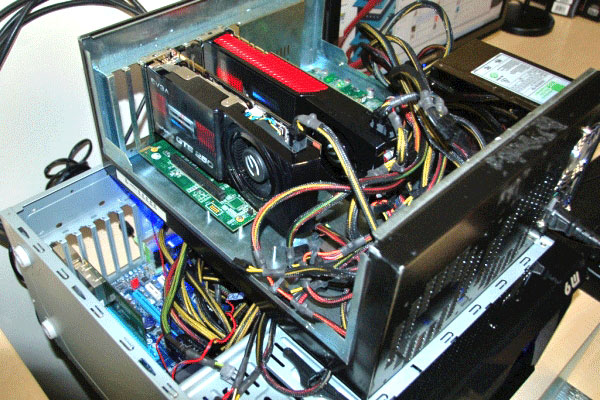Lucid Hydra 200 Multi-GPU Performance Revealed
HOW LUCID CONFIGURED THE TEST SYSTEM: We tested the graphics cards in this article using a unique setup provided by Lucid. The main components consist of a Gigabyte GA-EX58-UD3R motherboard powered by Intel's Core i7 920 quad-core processor and 2GB of OCZ DDR3 RAM. Of course, this particular motherboard does not feature Lucid technology so as a result, the graphics cards were installed on a special evaluation board featuring the Hydra 200 chip. The evaluation board was connected via PCIe card installed on an x16 slot on the GA-EX58-UD3R motherboard. We were told that this test setup simulates the performance of the Hydra 200 when integrated on a mainboard.
|
|
|
|
Hardware Used: |
Relevant Software: Windows 7 32-bit Benchmarks Used: 3DMark06 Operation Flashpoint: Dragon Rising Call of Juarez Benchmark Stormrise |
Lucid had several graphics cards and video games available for testing. Since time was a limiting factor, we could not test every videocard and game at our disposal but came up with five configurations and chose a handful of benchmarks in order to provide comparable results.
To find our baseline scores, we ran the benchmarks using an HD 4890 and GTX 260 individually. Next, we added identical graphics cards to the setup to determine scaling performance. In other words, we tested a pair of 4890's and two 260's together. The final combination consisted of a GTX 260 and HD 4890 simultaneously.
Some may wonder why we failed to use MSI's Big Bang Fuzion in our testing. For our meeting, Lucid actually had a separate test bed ready that featuried MSI's motherboard, an HD 4890, and a GTX 260. Initially, we sat down for a few minutes and played Operation Flashpoint: Dragon Rising on the system and acknowledge that it played very smoothly. Unfortunately, we must wait to see the performance numbers from MSI's Big Bang platform as they won't be released until the product has launched.
|
|
|










